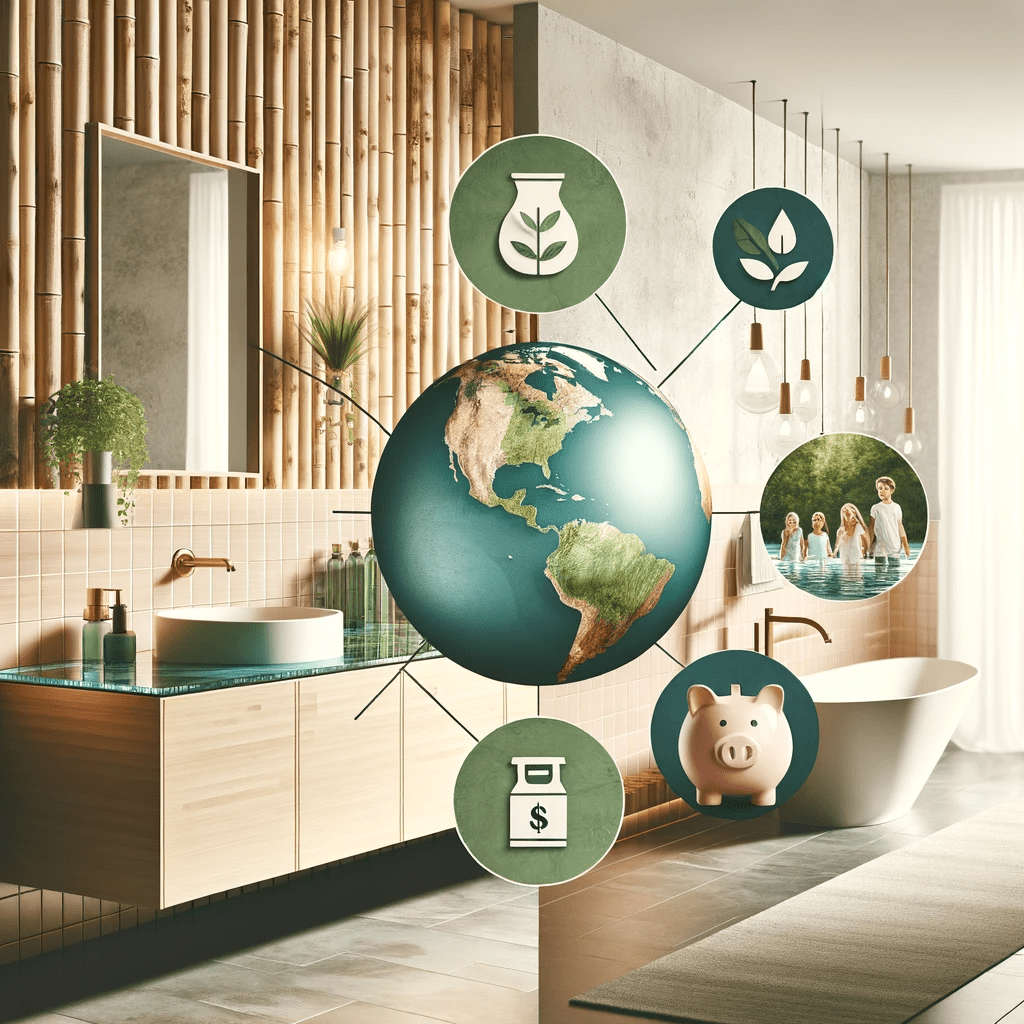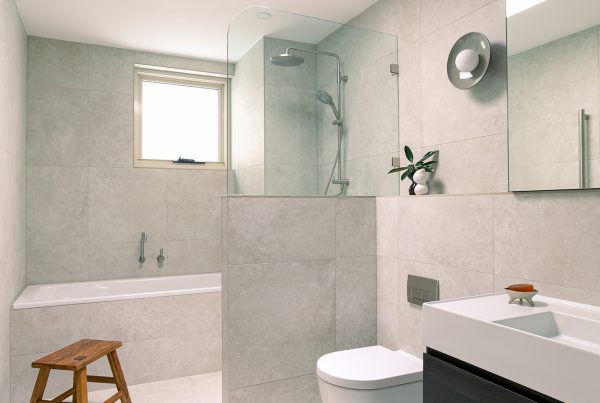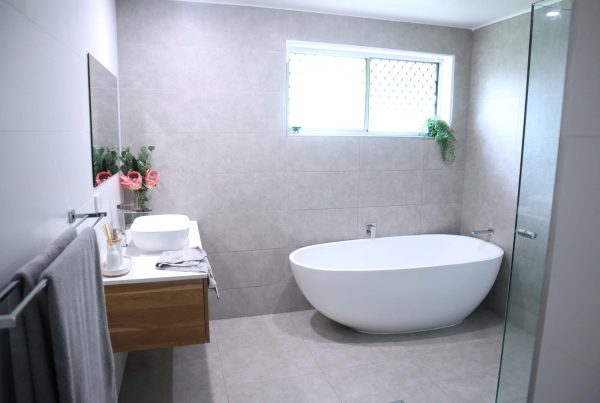Bathroom remodeling can be a significant expense, but there are ways to save money without sacrificing quality. One effective strategy is to use sustainable materials that can lower costs in the long run while also reducing your environmental impact. Here is a closer look at the benefits of using sustainable materials in your bathroom remodel, as well as some tips for incorporating these materials into your project.
Benefits of Using Sustainable Materials in Bathroom Remodeling
Lower Costs in the Long Run
Investing in sustainable materials and fixtures for your bathroom remodel might cost more upfront, but these choices often lead to significant savings over time. Here’s a detailed look at how these investments pay off:
High-Efficiency Fixtures:
- Water-Saving Toilets: Modern high-efficiency toilets use only about 4.8 liters per flush, compared to older models that use up to 13.2 liters. Over a year, this can save approximately 50,000 liters of water for an average family, significantly reducing your water bill.
- Low-Flow Showerheads: A standard showerhead uses about 9.5 liters of water per minute, whereas a low-flow model uses around 5.7 liters. For a daily 10-minute shower, the savings amount to over 13,800 liters per year.
Energy-Efficient Lighting:
LED vs. Traditional Bulbs: An LED bulb uses about 85% less energy than traditional incandescent bulbs and can last up to 25 times longer. Switching to LED can save about $75 in energy costs per bulb over its lifetime.
Durable Materials:
Longevity Comparison Table:
| Material Type | Average Lifespan | Initial Cost | Long-Term Savings |
|---|---|---|---|
| Standard Tiles | 10-20 years | Lower | Moderate |
| Porcelain Tiles | 20-30 years | Higher | High |
| Regular Paint | 3-5 years | Lower | Low |
| High-Quality Paint | 7-10 years | Higher | High |
Investing in higher-quality materials like porcelain tiles or high-quality paint can reduce the frequency and cost of repairs and replacements.
Cost-Benefit Analysis:
Short-Term vs. Long-Term Costs: While the initial investment in sustainable and efficient materials might be higher, the long-term savings can be substantial. For instance, the extra cost of a high-efficiency toilet could be recovered in water savings within a few years.
Government Incentives and Rebates:
Some regions offer rebates or incentives for installing energy-efficient or water-saving fixtures, further reducing the overall cost.
Choosing sustainable materials and efficient fixtures in your bathroom remodel may seem like a higher initial investment, but the long-term savings in utility bills and reduced repair costs make it a financially wise decision. Moreover, these choices support environmental sustainability, adding value beyond just monetary savings.
Reduced Environmental Impact
Incorporating sustainable materials into your bathroom remodel is not just a trend; it’s a significant step towards environmental stewardship. Here’s a deeper look at how these choices make a difference:
Resource Conservation:
Water-Saving Fixtures: High-efficiency toilets and faucets can save thousands of liters of water annually. For instance, a dual-flush toilet can save up to 67% of water compared to a traditional model.
Energy-Efficient Lighting: Switching to LED bulbs can reduce energy consumption by up to 80% compared to traditional incandescent bulbs.
Sustainable Material Usage:
Recycled Glass Tiles: Using recycled glass tiles for your bathroom reduces landfill waste. For every square meter of recycled glass tile used, approximately 8 kilograms of waste glass is diverted from landfills.
Bamboo Flooring: Bamboo grows rapidly, making it a more sustainable choice than traditional hardwood. It can mature in 3-5 years compared to 20-120 years for hardwoods.
Reducing Carbon Footprint:
Carbon Emission Reduction Table:
| Material Type | CO2 Emissions per Square Meter | Traditional vs. Sustainable |
|---|---|---|
| Standard Tile | High | Traditional |
| Recycled Tile | Low | Sustainable |
| Hardwood | Moderate to High | Traditional |
| Bamboo | Low | Sustainable |
Waste Minimization in Production:
Many sustainable materials involve production processes that generate less waste. For example, the manufacturing of composite materials often uses recycled content and produces minimal offcuts.
Lifecycle Analysis:
Sustainable materials typically have a longer lifespan and require less frequent replacement, thereby reducing the environmental impact over the material’s lifecycle.
Environmental Certifications:
Look for materials with certifications like Forest Stewardship Council (FSC) for wood products or GREENGUARD for low chemical emissions, ensuring they meet stringent environmental standards.
Cost vs. Environmental Savings:
While some eco-friendly options may have a higher initial cost, the long-term savings in terms of environmental impact are significant. For example, sustainable materials often have lower maintenance costs and longer lifespans.
Encouraging Eco-Friendly Industry Practices:
By choosing sustainable materials, consumers can drive demand for eco-friendly practices in the manufacturing industry, encouraging more companies to adopt sustainable methods.
Using sustainable materials in your bathroom remodel is a powerful way to reduce environmental impact. It’s about making a conscious choice to conserve resources, minimize waste, and support eco-friendly manufacturing practices. This approach not only contributes to a healthier planet but also aligns with a growing global emphasis on sustainability in home improvement.
Increased Resale Value
Integrating sustainable materials into your bathroom remodel not only benefits the environment but also boosts your home’s market appeal. Let’s delve into how this can enhance the resale value of your home:
Growing Market Trends:
Sustainability as a Selling Point: A recent survey showed that over 70% of homebuyers are more inclined to purchase eco-friendly homes.
Rise in Eco-Conscious Buyers: The demand for homes with sustainable features has increased significantly, with millennials leading the trend.
Valuation of Eco-Friendly Features:
Higher Resale Value: Homes with sustainable upgrades can see an increase in resale value by up to 7-10% compared to similar homes without such features.
Faster Sale Times: Eco-friendly homes often sell faster than their counterparts, reducing the time your property spends on the market.
ROI on Sustainable Materials:
| Sustainable Feature | Cost Increase | Resale Value Increase | ROI |
|---|---|---|---|
| Low-Flow Toilets | 1-2% | 3-4% | High |
| LED Lighting | <1% | 2-3% | High |
| Bamboo Flooring | 2-3% | 4-5% | Moderate-High |
Investing in these features can yield a significant return when it comes time to sell your home.
Energy Efficiency Certificates:
Homes with energy efficiency certificates, like ENERGY STAR, can command a higher price in the market.
Marketing the Sustainability Aspect:
When selling, highlight the sustainable features of your home. This can be a key differentiator and attract a specific buyer demographic.
Long-Term Savings for Buyers:
Sustainable features not only reduce environmental impact but also lower utility costs for future homeowners, making your property more attractive.
Increasing Awareness of Environmental Impact:
As awareness of environmental issues grows, homes with sustainable features are increasingly sought after, further boosting their value.
Insurance and Maintenance Benefits:
Some insurers offer discounts for eco-friendly homes, and sustainable materials often require less maintenance, adding to the overall appeal.
Incorporating sustainable materials in your bathroom remodel is a strategic move that goes beyond just environmental benefits. It can significantly increase the resale value of your home and make it more attractive to a growing pool of eco-conscious buyers. As the trend towards sustainability continues to rise, the investment in such materials is likely to pay off even more in the future.
Tips for Using Sustainable Materials in Bathroom Remodeling
Choose Water-Efficient Fixtures
Water-efficient fixtures such as low-flow toilets, showerheads, and faucets can significantly reduce water usage and lower your utility bills. Look for fixtures that are certified by organizations such as WaterSense to ensure that they meet high standards for efficiency and performance.
Table: Comparison of Water-Efficient Bathroom Fixtures (Sydney, Australia)
| Fixture Type | Standard Usage (Liters/Unit) | Water-Efficient Usage (Liters/Unit) | Annual Water Savings (Liters) | Potential Utility Bill Reduction (AUD) |
|---|---|---|---|---|
| Toilets | 13.2 liters/flush | 4.8 liters/flush | Up to 22,000 | Up to AUD $120-$180 |
| Showerheads | 9.5 liters/min | 5.7 liters/min | Over 13,800 | Up to AUD $90-$140 |
| Faucets | 8.3 liters/min | 5.7 liters/min | Up to 10,000 | Up to AUD $70-$110 |
Notes:
- Water savings are based on average household usage in Sydney.
- Utility bill reduction estimates are based on average water rates in Sydney.
- All water-efficient figures are approximate and represent common specifications for WaterSense-certified or equivalent products in Australia.
Use Recycled Materials
Using recycled materials such as glass, metal, and plastic can reduce the environmental impact of your bathroom remodel while also giving your bathroom a unique and stylish look. Consider using recycled glass tiles or recycled metal fixtures to add texture and visual interest to your space.
Table: Benefits of Using Recycled Materials in Bathroom Remodeling
| Recycled Material | Environmental Benefit | Aesthetic Appeal | Potential Applications |
|---|---|---|---|
| Glass Tiles | Reduces landfill waste; Lowers energy use in production | Offers unique colors and translucency | Shower walls, Backsplashes |
| Metal Fixtures | Decreases the demand for virgin metal; Energy-efficient in production | Adds a modern or industrial look | Faucets, Towel bars, Cabinet handles |
| Plastic Surfaces | Lessens plastic waste; Often made from consumer recyclables | Comes in various colors and patterns | Countertops, Shower surrounds |
| Reclaimed Wood | Saves trees; Lower environmental footprint than new wood | Provides a warm, rustic charm | Vanities, Shelving, Accent walls |
| Composite Materials | Often made from a mix of recycled materials | Versatile in design and texture | Countertops, Flooring |
Notes:
- The environmental benefits reflect the reduction in resource extraction and manufacturing impacts.
- Aesthetic appeal varies based on personal preference and the specific product chosen.
- Applications are suggestions; actual use may depend on the specific product and bathroom design.
Invest in Durable Materials
Investing in durable materials such as porcelain, ceramic, and stone can reduce the need for repairs and replacements down the line. These materials are long-lasting and can withstand daily wear and tear, making them a cost-effective choice in the long run.
Table: Comparing Durable Materials for Bathroom Remodeling
| Material Type | Durability | Wear and Tear Resistance | Long-Term Cost-Effectiveness | Common Uses in Bathroom |
|---|---|---|---|---|
| Porcelain | Very High | Excellent against scratches and moisture | High, due to less frequent need for replacement | Floor and wall tiles, Sinks |
| Ceramic | High | Good resistance to scratches, less so to heavy impact | Moderate to High, durable but more prone to chipping than porcelain | Tiles, Countertops |
| Stone | Very High | Excellent durability, varies by type (e.g., granite, marble) | High, especially for harder stones like granite | Countertops, Shower walls |
| Quartz | High | Highly resistant to stains and scratches | High, due to its longevity and low maintenance | Countertops, Backsplashes |
| Solid Surface | Moderate to High | Resistant to most stains and minor impacts | Moderate, seamless designs reduce potential for damage | Shower surrounds, Countertops |
Notes:
- Durability and wear and tear resistance are general characteristics and can vary based on quality and specific type of material.
- Long-term cost-effectiveness is evaluated based on the material’s lifespan and maintenance needs relative to its initial cost.
- Common uses in the bathroom are suggestions; actual applications may vary based on design preferences and practicality.
Opt for Non-Toxic Materials
Many traditional building materials such as paint, adhesives, and sealants can contain harmful chemicals that can affect indoor air quality and potentially harm your health. Look for non-toxic alternatives such as low-VOC paint and natural sealants to create a healthy and sustainable bathroom environment.
Table: Non-Toxic Materials for Bathroom Remodeling
| Material Type | Traditional Option | Non-Toxic Alternative | Health Benefits | Potential Uses in Bathroom |
|---|---|---|---|---|
| Paint | Standard Paint | Low-VOC or No-VOC Paint | Reduces exposure to harmful VOCs, better for indoor air quality | Walls, Ceilings |
| Adhesives | Standard Adhesives | Non-toxic, Water-based Adhesives | Avoids harmful fumes and chemicals, safer for use in enclosed spaces | Tile installation, Countertop fixing |
| Sealants | Traditional Sealants | Natural or Low-VOC Sealants | Less toxic, minimizes indoor air pollution | Sealing joints, Around sinks and bathtubs |
| Caulk | Synthetic Caulk | Non-toxic, Silicone-based Caulk | Free from harmful chemicals, prevents mold and mildew | Sealing gaps, Waterproofing edges |
| Flooring | Traditional Vinyl Flooring | Natural Linoleum or Cork Flooring | Free from PVC and phthalates, hypoallergenic | Bathroom Floors |
Notes:
- VOCs (Volatile Organic Compounds) are common in many traditional building materials and can contribute to indoor air pollution.
- Non-toxic alternatives often have a similar performance to traditional options but are safer for both health and the environment.
- Potential uses are based on typical applications in bathroom remodeling.
Consider Energy-Efficient Lighting
Energy-efficient lighting such as LED bulbs and fixtures can significantly reduce your energy usage and lower your utility bills. Look for fixtures that are Energy Star certified to ensure that they meet high standards for efficiency and performance.
Table: Energy-Efficient Lighting Options for Bathroom Remodeling
| Lighting Type | Traditional Option | Energy-Efficient Option | Energy Savings | Potential Utility Bill Reduction | Energy Star Certification |
|---|---|---|---|---|---|
| Bulbs | Incandescent Bulbs | LED Bulbs | Up to 85% less energy usage | Up to $75 per bulb over its lifetime | Look for Energy Star-certified bulbs |
| Ceiling Lights | Standard Ceiling Lights | LED Panel Lights | Up to 80% less energy usage | Varies by usage, significant over time | Prefer fixtures with Energy Star label |
| Vanity Lights | Halogen Bulbs | LED Vanity Lights | Up to 80% less energy usage | Up to $50 per fixture over its lifetime | Check for Energy Star certification |
| Accent Lighting | Traditional Spotlights | LED Accent Lights | Up to 85% less energy usage | Depends on number and usage of lights | Seek Energy Star-certified models |
| Task Lighting | Fluorescent Tubes | LED Strip Lights | Up to 75% less energy usage | Varies, but substantial over time | Look for Energy Star-rated products |
Notes:
- Energy savings are compared to traditional lighting options.
- Potential utility bill reduction is an estimate and will depend on the cost of electricity in your area and the amount of usage.
- Energy Star certification ensures that the lighting meets strict efficiency and performance criteria set by the US EPA.
By incorporating sustainable materials into your bathroom remodeling project, you can save money in the long run while also reducing your environmental impact and improving the value of your home. Make sure to carefully evaluate the costs and benefits of different sustainable materials, and to work with a contractor who has experience working with these materials.
Related Articles
-
Using Sustainable Materials to Save Money on Your Bathroom Remodel.
-
Ways to Negotiate with Contractors to Stay Within Your Budget for Bathroom Remodeling.
-
DIY vs. Hiring a Professional: Which Option is More Budget-Friendly for Bathroom Remodeling?
-
Financing Your Bathroom Remodel: The Pros and Cons
-
Cost Breakdown: Understanding the Expenses Involved in a Bathroom Renovation
-
How to Prioritize Your Spending During a Bathroom Remodel
-
How To Set a Realistic Budget For Your Bathroom Remodel
-
How Can I Modernize My Bathroom Cheaply?
-
How Can I Make My Bathroom Look Expensive?
-
How Much Does it Cost to Renovate a Bathroom?
-
How to Reduce Your Costs When Remodeling Your Bathroom
-
How Much Does It Cost to Replace the Bathroom?
-
How to Make the Most of a Small Bathroom Remodel Budget







